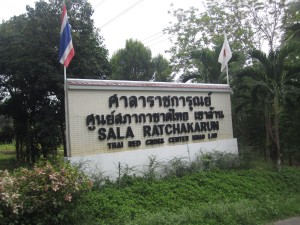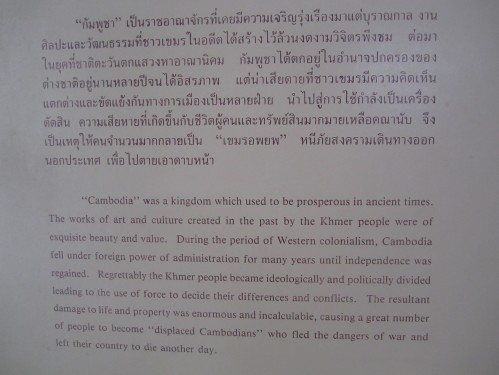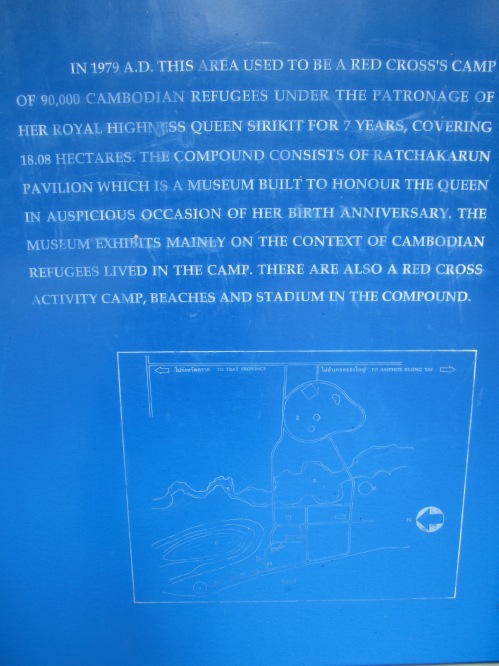 Our pick-up truck bounded down the smooth pavement, creating a muggy breeze. We moved down a strip of the coast, a highway and a shade of green I think I’ll forever associate with Thailand, and that’s the place the people came through. It was 30 years ago and there’s not a lot left—unless you know where to look.
Our pick-up truck bounded down the smooth pavement, creating a muggy breeze. We moved down a strip of the coast, a highway and a shade of green I think I’ll forever associate with Thailand, and that’s the place the people came through. It was 30 years ago and there’s not a lot left—unless you know where to look.
I didn’t. I kept craning my neck through the grating of the covered truck bed, trying to catch a sign for Khao Lan. I was lucky, I discovered, in that a giggly group of five teenage girls with straw mats and beach towels were getting off at Khao Lan as well. They’d spend the entire 40-minute ride squealing and chatting and texting. When we glided to an easy stop, they pointed and exclaimed to me, “Khao Lan!”
We trundled off, stood on the swampy roadside of a military checkpoint. “Beach?” one of the girls asked me shyly.
“Museum,” I replied.
“Museum,” she repeated softly. The word caused a buzz among her friends. “Museum!” one of them exclaimed assuredly, and pointed to a white structure obscured by the green.
I thanked them with a small bow of my head—I hadn’t learned “thank you” in Thai—and watched them disappear down the road.

The museum was modern, diagonal columns and a glass skylight structure that didn’t at all seem to fit the landscape. The adjoining parking lot was empty and the museum gates locked.
The guard at the military checkpoint back on the road made an eating motion. He pointed to his watch, held up one finger. I nodded and wandered back down towards the museum grounds, thinking how strangely simple it was, how much you could communicate without words, without a common language, just signs and gestures and hints, a smile and a bow.
 Green signs were stuck amid the grasses, and those communicated a lot less. Were they marking something related to the camp that had once stood there? I couldn’t be sure, but photographed them just in case.
Green signs were stuck amid the grasses, and those communicated a lot less. Were they marking something related to the camp that had once stood there? I couldn’t be sure, but photographed them just in case.
I walked deeper into the grounds. A buzz grew from the trees like a living thing, like it weren’t the product of a living thing, a million unseen insects, but an animal in and of itself. It whined and hissed and followed me down the road.
 There were beaten bits of earth, what had once been a road. Chunks of cement remained, with earth growing back up around it, like a scab before it peels. There were clearings in the grass, and I tried to figure out if they were remains or something used for farming, the stray huts I could spot off between the trees.
There were beaten bits of earth, what had once been a road. Chunks of cement remained, with earth growing back up around it, like a scab before it peels. There were clearings in the grass, and I tried to figure out if they were remains or something used for farming, the stray huts I could spot off between the trees.
But I walked further and found translated markers—something, not in a common language, but my language, a scribble I could understand. I held my breath and tried to imagine tents and roads and some 90,000 people.
I couldn’t. It was just wind and rubble, stairs to nowhere and the earth growing back up around.
The museum was open by the time I got back, and I slid off my shoes and stepped inside. A lone female attendant smiled at me and went back to sweeping the floor.
The museum was strange. It was mostly a tribute to the Queen, a tribute to her goodwill as evidenced by her selfless saving of Cambodian refugees. Everything was framed in that context—photographs of a glamorous white-skinned woman walking through a city of tents in a white suit, a floppy sun hat and Jackie-O sunglasses. She crouched beside the thin and sick, bellies swollen and eyes dulled, a look of practiced concern. She sat before a group of children, an opened book in her hands: The children listened rapt, the words of the Queen forever imprinted in their minds.

Subtext: Thailand is the only country in SE Asia to have never officially fallen under imperalist control.
But still, she’d done a good thing, a damn good thing. The museum included three life-size scenes that reminded me of wildlife dioramas, the kind my best friend meticulously restores, repainting eyes and gluing on fake fur.
Wax Cambodian figures, their bodies worn and their faces contorted by grief, stood in varying poses of despair, before a painting of thick jungle, more faces and bodies coming through the trees. Other scenes depicted varying elements of camp life: cooking pots of rice, a white woman holding a stethoscope to the chest of a small wax infant. The dark Cambodian bodies grew plumper, more solid.
I wondered if that’s what it’d looked like—the emergence from the woods and the camp life. I thought of the newsreel footage of camps I’d seen, the faces in the camps, and decided it was worse.
(“You’ve seen The Killing Fields?” Lisa asked my mom once. My mom said yes. Lisa nodded. “It was much worse.”)
For its oddity and drama, I wondered, if there were any other museums like this, that documented this particular snippet, this part of journey, this freeze-frame from the film reel of a movie you’ve never managed to see all of, keep catching out of sequence or coming in half-way through.
I stood barefoot in an empty museum of transience, while the earth outside slowly swallowed the remains of what was left, which wasn’t much at all. I tucked some crumbled bills into the donation box, slid my shoes back on, and stepped out into the heat.











Khao Lan was just a few klicks up the road from Mairut Camp. The Vietnamese occasionally mortared it because it was purported to be a strategic KR enclave. By contrast, Mairut Camp was only mortared once the two years I lived and worked there. But I don’t really know the full story behind Khao Lan. There were KR and Khmer Serika in Mairut some of whom repatriated to fight the Vietnamese occupation.
Absolutely love this series you’ve been doing and have had similar thoughts while documenting my travels. Solid narrative!